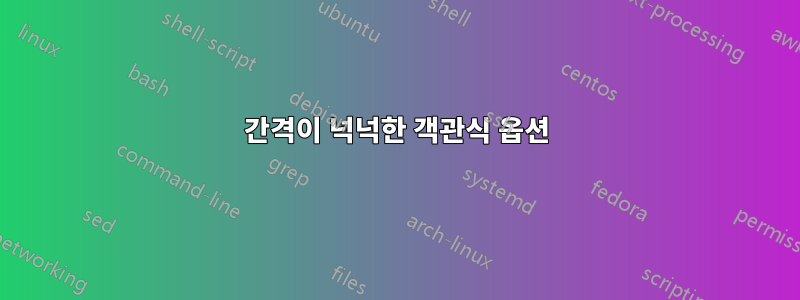
LaTeX를 사용하여 시험을 최대화하고 있으며 객관식 옵션을 만들기 위해 다음 명령을 사용합니다.
\newcommand{\mc}[5]{(\textbf{A}) #1 \qquad \qquad (\textbf{B}) #2 \qquad \qquad (\textbf{C}) #3 \qquad \qquad (\textbf{D}) #4 \qquad \qquad (\textbf{E}) #5}
그러나 작은 답변 선택(예: 1 또는 2) 또는 긴 답변(예: 이름 등)의 경우 답변 선택이 화면 전체에 완전히 맞지 않습니다. 각 옵션 사이에 하드 코딩된 공간이 있기 때문입니다. 와 함께 \qquad.
페이지 전체에 정확하게 맞도록 옵션 간격을 자동으로 올바르게 지정하는 방법이 있습니까?
미리 감사드립니다.
답변1
패키지 를 사용하는 대안은 다음과 같습니다 tasks.
\documentclass{article}
\usepackage{tasks}
\setlength{\parindent}{0pt}
\begin{document}
\textbf{Question}: Here is the question text. Answers are arranged in 4 columns.
\begin{tasks}(4)
\task first answer
\task second answer
\task third answer
\task fourth answer
\end{tasks}
\bigskip
\textbf{Question}: Here is the question text. Answers are arranged in 2 columns.
\begin{tasks}(2)
\task first answer
\task second answer
\task third answer
\task fourth answer
\end{tasks}
\bigskip
\textbf{Question}: Here is the question text. Answers are arranged in 2 columns and are longer than a single line.
\begin{tasks}(2)
\task first answer first answer first answer first answer
\task second answer second answer second answer
\task third answer
\task fourth answer
\end{tasks}
\end{document}
답변이 전체 텍스트 너비에 걸쳐 퍼지도록 하려면 tabularx다음과 같이 사용할 수 있습니다. (빨간색 수직선은 텍스트 블록의 너비를 나타냅니다.) 이 방법을 사용하면 첫 번째와 두 번째 열 사이, 두 번째 마지막 열과 마지막 열 사이의 공백이 다른 열 사이의 공백보다 커집니다. (또한보십시오이 댓글)
\documentclass{article}
\usepackage{tabularx}
\setlength{\parindent}{0pt}
\begin{document}
\textbf{Question}: Here is the question text. Answers are arranged in 4 columns and take up the entire textwidth.
\begin{tabularx}{\textwidth}{@{}X>{\centering\arraybackslash}X>{\centering\arraybackslash}X>{\raggedleft\arraybackslash}X@{}}
\textbf{A} first answer &
\textbf{B} second answer &
\textbf{C} third answer &
\textbf{D} fourth answer
\end{tabularx}
\end{document}
tabular*하나 와 조합하여 사용하면 \extracolsep{\fill}다음과 같은 출력을 얻을 수 있습니다. 여기서 인접한 열 사이의 가로 공백은 동일합니다. 답변이 너무 길고 줄 바꿈이 필요한 경우 p대신 열 유형으로 전환하는 것이 좋습니다. 또한 이 방법을 사용하면 각 답변이 차지하는 너비가 다릅니다.
\documentclass{article}
\setlength{\parindent}{0pt}
\begin{document}
\textbf{Question}: Here is the question text. Answers are arranged in 4 columns and take up the entire textwidth.
\setlength{\tabcolsep}{0pt}
\begin{tabular*}{\textwidth}{@{\extracolsep{\fill}}ccccc}
\textbf{A} 1 &
\textbf{B} 2 &
\textbf{C} 3 &
\textbf{D} 4 &
\textbf{E} 5
\end{tabular*}
\begin{tabular*}{\textwidth}{@{\extracolsep{\fill}}ccccc}
\textbf{A} 1 &
\textbf{B} 2 &
\textbf{C} 3 &
\textbf{D} 4 &
\textbf{E} longer text
\end{tabular*}
\begin{tabular*}{\textwidth}{@{\extracolsep{\fill}}ccccc}
\textbf{A} 1 &
\textbf{B} long text &
\textbf{C} 3 &
\textbf{D} 4 &
\textbf{E} longer text
\end{tabular*}
\end{document}
답변2
나는 여러 가지 방법이 있다고 확신합니다. 나는 유연성 때문에 TikZ 방식을 제안합니다. 이를 위해 새로운 명령을 작성할 수 있습니다.
\documentclass{article}
\usepackage{tikz}
\begin{document}
\centerline{\LARGE\bfseries\textcolor{blue}{TIKZ for multiple choices}}
\vspace*{1cm}
\noindent{\bfseries Question 1.} This question has $2$ choices.
\noindent\begin{tikzpicture}
\pgfmathsetmacro{\a}{\textwidth}
\path[font=\bfseries,blue]
(0,0) node{A. $x=1$}
++(0:\a/2 pt) node{B. $x=6$};
\end{tikzpicture}
\noindent{\bfseries Question 2.} This question has $3$ choices.
\noindent\begin{tikzpicture}
\pgfmathsetmacro{\a}{\textwidth}
\path[n/.style={font=\bfseries,circle,draw=blue,fill=gray!30},inner sep=1pt]
(0,0) node[n]{A} +(0:1) node{$m=3$}
++(0:\a/3 pt) node[n]{B} +(0:1) node{$m=4$}
++(0:\a/3 pt) node[n]{C} +(0:1) node{$m=3$};
\end{tikzpicture}
\noindent{\bfseries Question 3.} This question has $4$ choices.
\noindent\begin{tikzpicture}
\pgfmathsetmacro{\a}{\textwidth}
\path[font=\bfseries,blue,right]
(0,0) node{A. $x=1$}
++(0:\a/4 pt) node{B. $x=6$}
++(0:\a/4 pt) node{C. $x=8$}
++(0:\a/4 pt) node{D. $x=6688$};
\end{tikzpicture}
\noindent{\bfseries Question 4.} This question also has $4$ choices. You can see choices of Question $3$ and Question $4$ are vertically aligned.
\noindent\begin{tikzpicture}
\pgfmathsetmacro{\a}{\textwidth}
\path[font=\bfseries,magenta,right]
(0,0) node{A. $y=11$}
++(0:\a/4 pt) node{B. $y=66$}
++(0:\a/4 pt) node{C. $y=88$}
++(0:\a/4 pt) node{D. $y=668866$};
\end{tikzpicture}
\noindent{\bfseries Question 5.} This question also has $4$ choices with other arrangement.
\noindent\begin{tikzpicture}
\pgfmathsetmacro{\a}{\textwidth}
\path[font=\bfseries,right]
(0,0) node[blue] {A. Blue}
+(0:\a/2 pt) node[red] {B. Red}
++(-90:.5) node[violet] {C. Violet}
+(0:\a/2 pt) node[orange] {D. Orange};
\end{tikzpicture}
\end{document}






